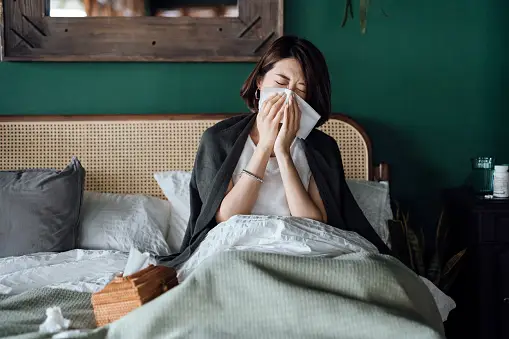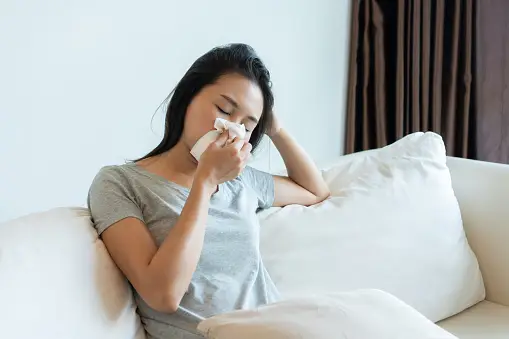The common cold is a prevalent viral infection that affects the upper respiratory tract, including the nose and throat. While typically mild and self-limiting, the common cold can cause discomfort and disrupt daily life, especially during colder months or when immunity is compromised.
Known for symptoms such as nasal congestion, sore throat, coughing, sneezing, and mild body aches, the common cold is caused by various strains of viruses, primarily rhinoviruses. Understanding its transmission, symptoms, and management can help individuals mitigate its impact and promote recovery. This introduction sets the stage for exploring the nuances of this widespread yet often underestimated illness.
Table of Contents
Symptoms of Common Cold

The common cold presents a range of symptoms that typically develop one to three days after exposure to the virus. These symptoms may include:
- Runny or Stuffy Nose: Nasal congestion or discharge is common, often accompanied by sneezing.
- Sore Throat: Irritation or discomfort in the throat, sometimes worsened by postnasal drip.
- Cough: A dry or productive cough may develop, contributing to throat irritation.
- Slight Body Aches: Mild body aches or headaches can occur, although they are usually less severe than with the flu.
- Fatigue: Feeling tired or lethargic is common, especially in the early stages of the illness.
- Mild Fever: Some individuals may experience a slight elevation in body temperature, although fever is less common in adults than in children.
- Watery Eyes: Eyes may become watery or irritated due to nasal congestion and inflammation.
- Loss of Appetite: A reduced desire to eat is typical during the course of the illness.
These symptoms typically last for about seven to ten days, though coughing and nasal congestion may persist for up to two weeks. While generally manageable with rest and supportive care, severe symptoms or complications may require medical attention, especially in vulnerable populations such as young children, older adults, or individuals with weakened immune systems.
Causes of Common Cold

The common cold is primarily caused by viral infections, with the most common culprits being rhinoviruses. However, several other types of viruses can also trigger cold symptoms. Here are the key causes:
- Rhinoviruses: These are the most frequent viral agents responsible for causing the common cold. There are over 100 known types of rhinoviruses, making them highly diverse in their ability to infect the upper respiratory tract.
- Coronaviruses: Some strains of coronaviruses, such as certain types of human coronaviruses (not including SARS-CoV-2, which causes COVID-19), can cause mild cold-like symptoms.
- Respiratory Syncytial Virus (RSV): RSV is another common cause of respiratory infections, particularly in young children, and can lead to cold symptoms.
- Influenza Viruses: While influenza viruses typically cause the flu, they can sometimes cause symptoms similar to a cold, especially in milder cases.
- Parainfluenza Viruses: These viruses are known to cause respiratory infections, including cold-like symptoms, particularly in young children.
- Enteroviruses: Certain types of enteroviruses can also contribute to cold symptoms, though they are less common than rhinoviruses.
Transmission:
The viruses that cause the common cold are highly contagious and spread through:
- Direct Contact: Touching surfaces or objects contaminated with the virus and then touching the mouth, nose, or eyes.
- Airborne Droplets: Inhalation of droplets expelled into the air when an infected person coughs or sneezes.
- Indirect Contact: Contact with respiratory secretions from an infected person, such as sharing utensils or personal items.
Understanding the causes and modes of transmission of the common cold can help individuals take preventive measures to reduce the risk of contracting and spreading the virus.
Risk Factors
Several factors can increase an individual’s risk of contracting the common cold or experiencing more severe symptoms. These risk factors include:
- Age: Children under the age of 6 are at higher risk due to their developing immune systems and frequent exposure in daycare or school settings. Older adults also have a higher risk of complications from cold viruses.
- Weakened Immune System: Individuals with weakened immune systems, such as those with chronic illnesses (e.g., diabetes, HIV/AIDS) or undergoing chemotherapy, are more susceptible to infections, including the common cold.
- Seasonal Variations: The common cold is more prevalent during certain seasons, particularly fall and winter, when people spend more time indoors and in closer contact with others.
- Environmental Exposure: Being in crowded or enclosed environments, such as schools, public transportation, or offices, increases the likelihood of exposure to cold viruses.
- Smoking: Smoking damages the respiratory tract and weakens the immune system, making smokers more susceptible to respiratory infections like the common cold.
- Poor Hygiene Practices: Not washing hands frequently, touching the face with unwashed hands, or sharing contaminated objects can facilitate the transmission of cold viruses.
- Chronic Conditions: Individuals with chronic respiratory conditions, such as asthma or chronic obstructive pulmonary disease (COPD), may experience more severe symptoms when infected with a cold virus.
- Stress: Chronic stress can weaken the immune system, making it harder for the body to fight off infections, including the common cold.
Understanding these risk factors can help individuals take preventive measures to reduce their chances of contracting the common cold, such as practicing good hygiene, maintaining a healthy lifestyle, and avoiding close contact with sick individuals during peak cold seasons.
How Is the Common Cold Diagnosed?

The diagnosis of the common cold is primarily based on clinical evaluation of symptoms and history, as laboratory testing is typically not necessary. Here are the common methods used to diagnose the common cold:
- Clinical Evaluation:
- Healthcare providers typically diagnose the common cold based on the characteristic symptoms reported by the patient, such as nasal congestion, sore throat, cough, and mild body aches. They may also inquire about recent exposure to sick individuals or crowded environments.
- Physical Examination:
- During a physical exam, healthcare providers may check for signs commonly associated with the common cold, such as nasal congestion, throat redness, and swollen lymph nodes.
- Exclusion of Other Conditions:
- Since the symptoms of the common cold can overlap with other respiratory infections, such as influenza or allergies, healthcare providers may rule out other possible causes based on the patient’s history and physical examination findings.
- Laboratory Tests:
- In most cases, laboratory tests, such as viral cultures or polymerase chain reaction (PCR) tests, are not routinely used to diagnose the common cold. These tests are more commonly used in research settings or when complications are suspected.
- Diagnostic Imaging:
- Diagnostic imaging, such as chest X-rays, is not typically needed to diagnose the common cold unless complications, such as secondary bacterial infections, are suspected.
- Clinical Judgment:
- Diagnosis of the common cold relies on clinical judgment and the recognition of typical symptom patterns. Most cases are self-diagnosed based on the recognizable symptoms and do not require formal medical evaluation unless symptoms worsen or complications develop.
In summary, healthcare providers diagnose the common cold primarily based on the characteristic symptoms reported by the patient and a physical examination. Laboratory tests are generally unnecessary unless complications or other conditions are suspected. Management typically focuses on supportive care to relieve symptoms and promote recovery.
Treatment

Treatment for the common cold focuses on relieving symptoms and supporting the body’s natural immune response, as there is no cure for the viral infection itself. Here are key strategies and treatments commonly recommended:
- Rest and Hydration:
- Getting plenty of rest allows the body to recover more effectively. Drinking fluids, such as water, herbal teas, or clear broths, helps prevent dehydration and loosens mucus.
- Over-the-Counter Medications:
- Pain and Fever Relief: Acetaminophen (Tylenol) or ibuprofen (Advil, Motrin) can alleviate headaches, body aches, and reduce fever.
- Decongestants: Over-the-counter nasal decongestant sprays or oral decongestants (pseudoephedrine) may help relieve nasal congestion, but they should be used sparingly and only as directed to avoid rebound congestion.
- Cough Suppressants: If coughing is bothersome, cough suppressants containing dextromethorphan can help reduce cough frequency.
- Antihistamines: Antihistamines like diphenhydramine (Benadryl) may help alleviate runny nose and sneezing, although they can cause drowsiness.
- Saline Nasal Sprays or Rinses:
- Saline nasal sprays or rinses can help alleviate nasal congestion and improve breathing by flushing out mucus and allergens from the nasal passages.
- Humidifiers:
- Using a humidifier or vaporizer in the bedroom can add moisture to the air, which helps relieve nasal congestion and throat irritation.
- Throat Lozenges or Gargles:
- Throat lozenges or gargling with warm salt water can soothe a sore throat and reduce discomfort.
- Herbal Remedies and Supplements:
- Some people find relief from symptoms with herbal remedies like echinacea, zinc lozenges, or vitamin C supplements, although evidence supporting their effectiveness is mixed.
- Avoidance of Irritants:
- Avoiding smoke, pollutants, and other irritants can help reduce symptoms and prevent further irritation of the respiratory tract.
- Antibiotics:
- Antibiotics are not effective against viral infections like the common cold and should only be used if bacterial complications develop, such as a secondary bacterial sinus infection.
- Natural Remedies:
- Using natural remedies such as honey for cough suppression or ginger for soothing throat irritation can provide relief for some individuals.
It’s important to consult with a healthcare provider before starting any new medications or supplements, especially for individuals with pre-existing health conditions or those taking other medications. Most cases of the common cold resolve on their own within a week to 10 days with supportive care and symptom management.
Preventing

Preventing the common cold involves taking proactive steps to reduce exposure to viruses and boost immune defenses. While it’s challenging to completely prevent colds due to their widespread nature, especially during colder months, here are effective preventive measures:
- Hand Hygiene:
- Wash hands frequently with soap and water for at least 20 seconds, especially after coughing, sneezing, or touching surfaces in public places. Use alcohol-based hand sanitizers if soap and water are not available.
- Avoid Touching Face:
- Avoid touching your eyes, nose, and mouth with unwashed hands, as these are entry points for viruses.
- Cover Coughs and Sneezes:
- Cover your mouth and nose with a tissue or your elbow when coughing or sneezing to prevent spreading respiratory droplets.
- Stay Home When Sick:
- If you have cold symptoms, stay home from work, school, or social gatherings to rest and prevent spreading the virus to others.
- Clean and Disinfect:
- Regularly clean and disinfect frequently touched surfaces, such as doorknobs, countertops, and phones, to reduce the spread of viruses.
- Avoid Close Contact:
- Minimize close contact with individuals who are sick, and if possible, maintain a distance of at least 6 feet from others, especially during peak cold seasons.
- Boost Immune Health:
- Maintain a healthy lifestyle with regular exercise, balanced nutrition, and adequate sleep to support immune function. Consider incorporating immune-boosting foods like fruits, vegetables, and probiotics into your diet.
- Stay Hydrated:
- Drink plenty of fluids, such as water and herbal teas, to keep mucous membranes moist and support immune function.
- Consider Vaccination:
- While there is no vaccine specifically for the common cold, getting vaccinated against influenza (flu) can help prevent some respiratory infections that present similar symptoms to colds.
- Manage Stress:
- Chronic stress weakens the immune system, making it harder to fight off infections. Practice stress-reducing techniques such as yoga, meditation, or deep breathing exercises.
By incorporating these preventive measures into your daily routine, you can reduce your risk of contracting the common cold and promote overall wellness throughout the year.
Related Conditions
Several conditions are related to or share symptoms with the common cold. These include:
- Influenza (Flu): Influenza is a viral respiratory infection caused by influenza viruses. It shares some symptoms with the common cold, such as nasal congestion, sore throat, cough, and fatigue, but influenza symptoms tend to be more severe and can include high fever, body aches, and respiratory complications.
- Allergic Rhinitis (Hay Fever): Allergic rhinitis is an immune response to allergens such as pollen, dust mites, or pet dander. Symptoms include nasal congestion, sneezing, runny nose, and itchy eyes. While it shares symptoms with the common cold, allergic rhinitis is chronic and usually triggered by specific allergens rather than viruses.
- Sinusitis: Sinusitis is inflammation or infection of the sinuses, often caused by viral infections, bacterial infections, or allergies. Symptoms include nasal congestion, facial pain or pressure, headache, and postnasal drip. It can develop as a complication of the common cold or other respiratory infections.
- Bronchitis: Bronchitis is inflammation of the bronchial tubes, typically caused by viruses or bacteria. Symptoms include cough (productive or dry), chest discomfort, and fatigue. Acute bronchitis can develop following a viral respiratory infection such as the common cold.
- COVID-19: COVID-19 is caused by the SARS-CoV-2 virus and can present with symptoms similar to the common cold, including cough, sore throat, fatigue, and fever. However, COVID-19 symptoms can range from mild to severe and may include shortness of breath and loss of taste or smell, distinguishing it from a typical cold.
- Respiratory Syncytial Virus (RSV) Infection: RSV is a common respiratory virus that can cause symptoms similar to the common cold, especially in young children. It can lead to more severe respiratory infections, such as bronchiolitis or pneumonia, in infants and older adults with weakened immune systems.
- Pneumonia: Pneumonia is a bacterial, viral, or fungal infection of the lungs that can develop as a complication of respiratory infections like the common cold or influenza. Symptoms include cough, fever, chest pain, and difficulty breathing.
Recognizing the differences and similarities between these conditions is important for accurate diagnosis and appropriate treatment. If symptoms are severe or persist, especially if accompanied by high fever, difficulty breathing, or worsening symptoms, it’s important to seek medical evaluation and guidance promptly.
Living With the Common Cold

Living with the common cold involves managing symptoms and supporting your body’s recovery while preventing the spread of the virus to others. Here are some tips for navigating life with a cold:
- Rest and Hydration:
- Get plenty of rest to allow your body to recover. Adequate sleep and relaxation support your immune system’s efforts to fight off the virus. Drink plenty of fluids, such as water, herbal teas, and clear broths, to stay hydrated and help thin mucus.
- Symptom Relief:
- Use over-the-counter medications as needed to alleviate symptoms. Acetaminophen or ibuprofen can reduce fever and relieve body aches. Nasal decongestants or saline nasal sprays help clear nasal passages, while cough suppressants or lozenges can ease coughing and throat irritation.
- Humidify the Air:
- Use a humidifier or vaporizer in your bedroom to add moisture to the air. This can help relieve nasal congestion and soothe throat discomfort.
- Practice Good Hygiene:
- Wash your hands frequently with soap and water for at least 20 seconds, especially after coughing, sneezing, or blowing your nose. Avoid touching your face with unwashed hands to prevent spreading the virus.
- Cover Coughs and Sneezes:
- Use a tissue or your elbow to cover your mouth and nose when coughing or sneezing. Dispose of tissues immediately and wash your hands afterward to prevent spreading respiratory droplets.
- Avoid Close Contact:
- Minimize close contact with others, especially infants, older adults, and individuals with weakened immune systems who are more susceptible to infections.
- Stay Home When Sick:
- If possible, stay home from work, school, or social activities to rest and prevent spreading the virus to others. Resume normal activities once symptoms improve and fever has subsided for at least 24 hours without the use of fever-reducing medications.
- Manage Discomfort:
- Use warm saltwater gargles or throat lozenges to soothe a sore throat. Apply a warm compress to your forehead or sinuses to ease discomfort from sinus pressure.
- Monitor Symptoms:
- Pay attention to your symptoms and seek medical attention if they worsen or if you develop severe symptoms such as high fever, persistent cough, difficulty breathing, or chest pain.
- Support Immune Health:
- Maintain a healthy lifestyle with balanced nutrition, regular exercise, and stress management to support your immune system’s ability to fight off infections.
While the common cold is usually mild and resolves on its own within a week to 10 days, taking these steps can help manage symptoms, prevent complications, and promote a faster recovery. If you have concerns about your symptoms or if they persist or worsen, consult with a healthcare provider for guidance tailored to your individual needs.
Conclusion
In conclusion, living with the common cold involves managing symptoms while supporting your body’s natural healing process. While typically a mild and self-limiting illness, the common cold can cause discomfort and disrupt daily routines temporarily.
By practicing good hygiene, resting adequately, staying hydrated, and using over-the-counter medications as needed, you can alleviate symptoms and reduce the risk of spreading the virus to others. It’s important to listen to your body, take time to rest, and seek medical advice if symptoms persist or worsen. With proper care and attention, most people recover from the common cold within a week to 10 days and can resume normal activities gradually
